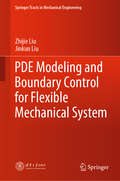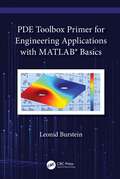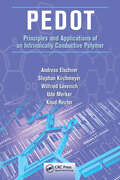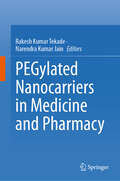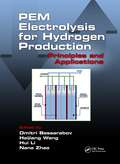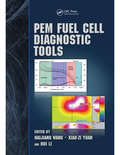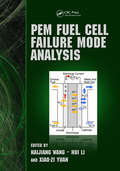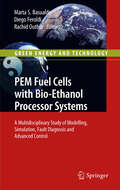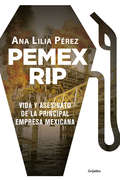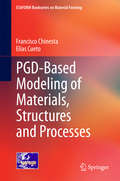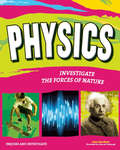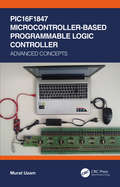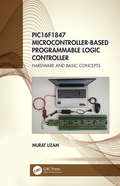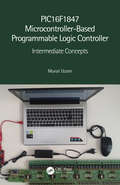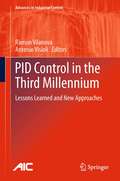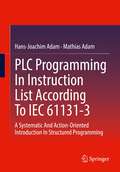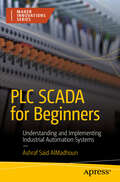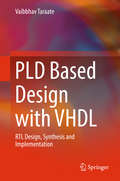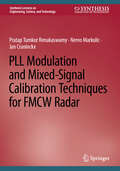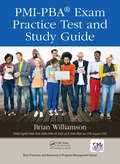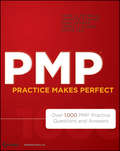- Table View
- List View
PDE Modeling and Boundary Control for Flexible Mechanical System (Springer Tracts in Mechanical Engineering)
by Jinkun Liu Zhijie LiuThis book provides a comprehensive review of fundamental issues in the dynamical modeling and vibration control design for several flexible mechanical systems, such as flexible satellites, flexible aerial refueling hoses, and flexible three-dimensional manipulators. Offering an authoritative reference guide to the dynamics and control of flexible mechanical systems, it equips readers to solve a host of problems concerning these systems. It provides not only a complete overview of flexible systems, but also a better understanding of the technical levels involved. The book is divided into ten chapters: Chapters 1 and 2 lay the foundations, while the remaining chapters explore several independent yet related topics in detail. The book’s final chapter presents conclusions and recommendations for future research.Given its scope, the book is intended for researchers, graduate students, and engineers whose work involves control systems, flexible mechanical systems, and related areas.
PDE Toolbox Primer for Engineering Applications with MATLAB® Basics
by Leonid BursteinPartial differential equations (PDEs) describe technological phenomena and processes used for the analysis, design, and modeling of technical products. Solutions of spatial and transient PDEs are realized by using the PDE Toolbox included in the MATLAB® software. MATLAB® is introduced here as an essential foundation for PDE, and the Modeler of the PDE Toolbox, with appropriate explanatory solutions, is applied to engineering problems in mechanics, heat/mass transfer, tribology, materials science, physics, and biotechnology. The appendixes contain collections of commands and functions used to solve actual engineering problems. FEATURES Includes the PDE Modeler interface with example solutions of two- and three-dimensional PDEs Presents methodologies for all types of PDEs as representative of any engineering problem Describes the ordinate differential equation (ODE) solver for initial value and boundary value problems (IVP and BVP) through practical examples from mechanics and the thermodynamic properties of materials Covers the basics of MATLAB® to solve both ODEs and PDEs Reviews spatially the one-dimensional PDE solver with actual engineering examples PDE Toolbox Primer for Engineering Applications with MATLAB® Basics is aimed at scientists, students, professionals, practitioners, self-taught readers, and researchers who need concise and clear information to study and apply MATLAB® software and the PDE Toolbox in engineering.
PEDOT: Principles and Applications of an Intrinsically Conductive Polymer
by Andreas Elschner Stephan Kirchmeyer Wilfried Lovenich Udo Merker Knud ReuterWhile there is information available in handbooks on polythiophene chemistry and physics, until now, few if any books have focused exclusively on the most forwardly developed electrically conductive polymer, Poly (3,4-ethylenedioxythiophene)-otherwise known as PEDOT. This resource provides full chemical, physical, and technical information about this important conducting polymer, discussing basic knowledge and exploring its technical applications. Presented information is based on information generated at universities and through academic research, as well as by industrial scientists, providing a complete picture of the experimental and the practical aspects of this important polymer.
PEGylated Nanocarriers in Medicine and Pharmacy
by Rakesh Kumar Tekade Narendra Kumar JainThis book shelters the central principles, cutting-edge methodologies, and incipient thought processes applied to PEGylation research. The content also expounds on the critical properties of PEG and other polymers that can be applied to formulate a prolonged-circulating nanocarrier system for the delivery of gene, nucleic acid, drugs, protein, and peptide and diagnostic agents. The book summarizes the methodologies and effects of PEGylation on drug delivery and highlights recent developments in PEGylated drugs. It also aims to present vital biopharmaceutical fates of PEGylated therapeutics and examines the approaches involved in the preparation, physicochemical properties, and biological applications of long-circulating PEGylated pharmaceutical nanocarriers. This book also cross-talks and offers expert viewpoints on mucus-penetrating PEGylated nanocarrier, reversible PEGylation of nanocarriers, and Bio-PEGylation as well as PEGylation and its alternatives. The book also deals with hottopics including the current status and regulatory aspects of PEGylated Nanoproducts, and medicinal and pharmaceutical applications of PEGylated Nanocarriers. The book provides a comprehensive literature resource for the students, biologists, chemists, toxicologists, medical researchers, scientists in industries, research institutes, universities, and consultants involved in the development and testing of new advanced medicines
PEM Electrolysis for Hydrogen Production: Principles and Applications
by Hui Li Dmitri Bessarabov Haijiang Wang Nana ZhaoAn ever-increasing dependence on green energy has brought on a renewed interest in polymer electrolyte membrane (PEM) electrolysis as a viable solution for hydrogen production. While alkaline water electrolyzers have been used in the production of hydrogen for many years, there are certain advantages associated with PEM electrolysis and its relevan
PEM Fuel Cell Diagnostic Tools
by Hui Li Haijiang Wang Xiao-Zi YuanPEM Fuel Cell Diagnostic Tools presents various tools for diagnosing PEM fuel cells and stacks, including in situ and ex situ diagnostic tools, electrochemical techniques, and physical/chemical methods. The text outlines the principles, experimental implementation, data processing, and application of each technique, along with its capabilities and
PEM Fuel Cell Failure Mode Analysis
by Hui Li Haijiang Wang Xiao-Zi YuanPEM Fuel Cell Failure Mode Analysis presents a systematic analysis of PEM fuel cell durability and failure modes. It provides readers with a fundamental understanding of insufficient fuel cell durability, identification of failure modes and failure mechanisms of PEM fuel cells, fuel cell component degradation testing, and mitigation strategies agai
PEM Fuel Cells with Bio-Ethanol Processor Systems
by Rachid Outbib Diego Feroldi Marta S. BasualdoAn apparently appropriate control scheme for PEM fuel cells may actually lead to an inoperable plant when it is connected to other unit operations in a process with recycle streams and energy integration. PEM Fuel Cells with Bio-Ethanol Processor Systems presents a control system design that provides basic regulation of the hydrogen production process with PEM fuel cells. It then goes on to construct a fault diagnosis system to improve plant safety above this control structure. PEM Fuel Cells with Bio-Ethanol Processor Systems is divided into two parts: the first covers fuel cells and the second discusses plants for hydrogen production from bio-ethanol to feed PEM fuel cells. Both parts give detailed analyses of modeling, simulation, advanced control, and fault diagnosis. They give an extensive, in-depth discussion of the problems that can occur in fuel cell systems and propose a way to control these systems through advanced control algorithms. A significant part of the book is also given over to computer-aided engineering software tools that can be used to evaluate the dynamic performance of the overall plant. PEM Fuel Cells with Bio-Ethanol Processor Systems is intended for use by researchers and advanced students on chemical, electrical-electronic and mechanical engineering courses in which dynamics and control are incorporated with the traditional steady-state coverage of flowsheet synthesis, engineering economics and optimization.
PEMEX RIP: Vida y asesinato de la principal empresa mexicana
by Ana Lilia PérezCon un estilo eficaz y fuentes de gran calado, este libro responde a una falta en el periodismo nacional sobre la industria que marcó la mayor parte del siglo XX en México y que actualmente toma un rumbo indefinido pero bastante negativo. A partir de la nacionalización de la industria petrolera, por ochenta años Pemex fue el principal sostén de la economía mexicana, una maquinaria generadora de billones y billones de dólares por la producción y venta del oro negro y sus derivados, sólo que, a pesar de ser un bien público, sus ganancias y beneficios se repartieron entre pocas manos. Al cabo de esas ocho décadas, la reforma energética, que acabó con el modelo nacionalista, hizo escombros el Pemex de Cárdenas: deliberadamente, la producción se derrumbó para dar paso a la desnacionalización y privatización. Pero ¿quiénes se enriquecieron de la gallina de los huevos de oro?, ¿dónde quedó la ganancia de la renta petrolera? A estas y otras interrogantes da respuesta este libro, que explica el entramado que llevó al declive y desmantelamiento de la industria petrolera mexicana. Pemex RIP cierra una trilogía sobre Pemex iniciada con Camisas Azules, Manos Negras. El saqueo de Pemex desde Los Pinos (2010) y El Cártel Negro. Cómo el crimen organizado se ha apoderado de Pemex (2011), en la que revela fraudes, peculado, abuso de poder, tráfico de influencias, enriquecimiento ilícito, sobornos y muchos otros abusos de funcionarios y empleados que tuvieron en sus manos la encomienda de dirigir y operar una de las petroleras más importantes del mundo, y que en sus manos la convirtieron en epicentro de corrupción del país.
PEMEX RIP: Vida y asesinato de la principal empresa mexicana
by Ana Lilia PérezCon un estilo eficaz y fuentes de gran calado, este libro responde a una falta en el periodismo nacional sobre la industria que marcó la mayor parte del siglo XX en México y que actualmente toma un rumbo indefinido pero bastante negativo. A partir de la nacionalización de la industria petrolera, por ochenta años Pemex fue el principal sostén de la economía mexicana, una maquinaria generadora de billones y billones de dólares por la producción y venta del oro negro y sus derivados, sólo que, a pesar de ser un bien público, sus ganancias y beneficios se repartieron entre pocas manos. Al cabo de esas ocho décadas, la reforma energética, que acabó con el modelo nacionalista, hizo escombros el Pemex de Cárdenas: deliberadamente, la producción se derrumbó para dar paso a la desnacionalización y privatización. Pero ¿quiénes se enriquecieron de la gallina de los huevos de oro?, ¿dónde quedó la ganancia de la renta petrolera? A estas y otras interrogantes da respuesta este libro, que explica el entramado que llevó al declive y desmantelamiento de la industria petrolera mexicana. Pemex RIP cierra una trilogía sobre Pemex iniciada con Camisas Azules, Manos Negras. El saqueo de Pemex desde Los Pinos (2010) y El Cártel Negro. Cómo el crimen organizado se ha apoderado de Pemex (2011), en la que revela fraudes, peculado, abuso de poder, tráfico de influencias, enriquecimiento ilícito, sobornos y muchos otros abusos de funcionarios y empleados que tuvieron en sus manos la encomienda de dirigir y operar una de las petroleras más importantes del mundo, y que en sus manos la convirtieron en epicentro de corrupción del país.
PGD-Based Modeling of Materials, Structures and Processes
by Francisco Chinesta Elías CuetoThis book focuses on the development of a new simulation paradigm allowing for the solution of models that up to now have never been resolved and which result in spectacular CPU time savings (in the order of millions) that, combined with supercomputing, could revolutionize future ICT (information and communication technologies) at the heart of science and technology. The authors have recently proposed a new paradigm for simulation-based engineering sciences called Proper Generalized Decomposition, PGD, which has proved a tremendous potential in many aspects of forming process simulation. In this book a review of the basics of the technique is made, together with different examples of application.
PHYSICS
by Jane P. Gardner Samuel CarbaughHave you ever noticed that the physical world works in certain ways? When you push an object it moves. Skateboarders use force and motion to perform tricks. If you jump up as high as you can, you'll quickly fall back to the ground. Baseball players use gravity to bring the ball back down when they throw it. When you flip a switch, electricity powers your toaster. Rock bands use electricity to put on a show. The fascinating science of physics helps you understand why forces, motion, gravity, electricity, light, and sound work in predictable ways.Combining inquiry-based, age-appropriate activities with physics topics, Physics: Investigate the Forces of Nature features graphic novel illustrations, fascinating sidebars, youtube links, and a glossary of important vocabulary to illuminate the complex world of physics and bring it to life. Projects include designing a skateboard park that maps the forces at work on the skateboarder and the skateboard, arguing your way out of a speeding ticket using the properties of physics, and creating a stage design for a rock band that places electric current where it is needed. Additional materials include a list of current reference works, websites, and Internet resources.
PIC16F1847 Microcontroller-Based Programmable Logic Controller: Advanced Concepts
by Murat UzamThe PIC16F1847-Based PLC project supports up to 4 analog inputs and 1 analog output, 1 High Speed Counter, 2 PWM (pulse width modulation) outputs, 1 Drum Sequencer Instruction with up to 16 steps, the implementation of Sequential Function Charts (SFCs) with up to 24 steps. This volume presents advanced concepts of the PIC16F1847-Based PLC project and consists of topics like program control, high speed counter and PWM macros. It further explains memory related drum sequencer instruction, sequential functional charts, and analog input and output modules. Aimed at researchers and graduate students in electrical engineering, power electronics, robotics and automation, sensors, this book: Presents program control macros to enable or disable a block of PLC program or to move execution of a program from one place to another. Proposes a High-Speed Counter and four PWM Macros for high speed counting and PWM operations. Develops memory related macros to enable the user to do memory read/write operations. Provides a Drum Sequencer instruction with up to 16 steps and 16 outputs on each step. Discusses the implementation of Sequential Function Chart (SFC) elements with up to 24 steps.
PIC16F1847 Microcontroller-Based Programmable Logic Controller: Hardware and Basic Concepts
by Murat UzamProgrammable logic controllers (PLCs) have been used extensively and are offered in terms of functions, program memories, and the number of inputs/outputs (I/Os), ranging from a few to thousands. With a focus on how to design and implement a PLC, this volume explains hardware and associated basic concepts of PLC. Authors have used PIC16F1847 microcontroller with: 8192 words of Flash program memory, 1024 bytes of SRAM data memory, 256 bytes of EEPROM data memory, the maximum operating speed of 32 MHz, 16-level deep hardware stack, an enhanced instruction set consisting of 49 single-word instructions. Flowcharts are provided to help the understanding of macros (instructions). Aimed at researchers and graduate students in electrical engineering, power electronics, robotics and automation, sensors, this book: Explains how to design and use a PIC16F1847 microcontroller-based PLC. Provides easy to use software structures written by using the PIC Assembly programming language. Describes a PLC from a designer's perspective. Explains the basic hardware and basic software structures of the PIC16F1847 based PLC. Focuses on concepts like Contact and Relay Based Macros, Flip-Flop Macros, Timer Macros, Counter Macros and Comparison Macros.
PIC16F1847 Microcontroller-Based Programmable Logic Controller: Intermediate Concepts
by Murat UzamThe volume focusses on intermediate concepts of the PIC16F1847-Based PLC project, and covers arithmetical operation ability of PLCs, logical function performers and operations like AND, NAND, OR, NOR. Further, it explains shift and rotate macros moving bits in a register to right or left, and selection macros enabling one value to be selected from several given values according to certain criteria. Demultiplexer circuit is illustrated, which is used to send a signal to one of many devices. Finally, it explains decoder, priority encoder and conversion macros. All the concepts are supported using flowcharts. Aimed at researchers and graduate students in electrical engineering, power electronics, robotics and automation, sensors, this book: Presents arithmetical and logical macros to carry out arithmetical and logical operations to be used for 8-bit or 16-bit variables and/or constant values. Provides shift and rotate macros to do arithmetical or logical shift and rotate operations to be used for 8-bit or 16-bit variables. Proposes selection macros to enable the user to do 8-bit or 16-bit move, load, selection, maximum, minimum, limiting, multiplexing and byte multiplexing operations. Develops demultiplexer macros, decoder macros and priority encoder macros to be used as combinational circuits. Presents conversion macros to provide functions to convert given data from one format to another one.
PID Control in the Third Millennium
by Antonio Visioli Ramon VilanovaThe early 21st century has seen a renewed interest in research in the widely-adopted proportional-integral-differential (PID) form of control. PID Control in the Third Millennium provides an overview of the advances made as a result. Featuring: new approaches for controller tuning; control structures and configurations for more efficient control; practical issues in PID implementation; and non-standard approaches to PID including fractional-order, event-based, nonlinear, data-driven and predictive control; the nearly twenty chapters provide a state-of-the-art resumé of PID controller theory, design and realization. Each chapter has specialist authorship and ideas clearly characterized from both academic and industrial viewpoints. PID Control in the Third Millennium is of interest to academics requiring a reference for the current state of PID-related research and a stimulus for further inquiry. Industrial practitioners and manufacturers of control systems with application problems relating to PID will find this to be a practical source of appropriate and advanced solutions.
PID Controller Tuning Using the Magnitude Optimum Criterion
by Konstantinos G. PapadopoulosAn instructive reference that will help control researchers and engineers, interested in a variety of industrial processes, to take advantage of a powerful tuning method for the ever-popular PID control paradigm. This monograph presents explicit PID tuning rules for linear control loops regardless of process complexity. It shows the reader how such loops achieve zero steady-position, velocity, and acceleration errors and are thus able to track fast reference signals. The theoretical development takes place in the frequency domain by introducing a general-transfer-function-known process model and by exploiting the principle of the magnitude optimum criterion. It is paralleled by the presentation of real industrial control loops used in electric motor drives. The application of the proposed tuning rules to a large class of processes shows that irrespective of the complexity of the controlled process the shape of the step and frequency response of the control loop exhibits a specific performance. This specific performance, along with the PID explicit solution, formulates the basis for developing an automatic tuning method for the PID controller parameters which is a problem often met in many industry applications--temperature, pH, and humidity control, ratio control in product blending, and boiler-drum level control, for example. The process of the model is considered unknown and controller parameters are tuned automatically such that the aforementioned performance is achieved. The potential both for the explicit tuning rules and the automatic tuning method is demonstrated using several examples for benchmark process models recurring frequently in many industry applications.
PID Tuning: A Modern Approach via the Weighted Sensitivity Problem
by Salvador Alcántara Cano Ramon Vilanova Arbós Carles Pedret i FerréThe PID controller is the most common option in the realm of control applications and is dominant in the process control industry. Among the related analytical methods, Internal Model Control (IMC) has gained remarkable industrial acceptance due to its robust nature and good set-point responses. However, the traditional application of IMC results in poor load disturbance rejection for lag-dominant and integrating plants. This book presents an IMC-like design method which avoids this common pitfall and is devised to work well for plants of modest complexity, for which analytical PID tuning is plausible. For simplicity, the design only focuses on the closed-loop sensitivity function, including formulations for the H∞ and H2 norms. Aimed at graduate students and researchers in control engineering, this book: Considers both the robustness/performance and the servo/regulation trade-offs Presents a systematic, optimization-based approach, ultimately leading to well-motivated, model-based, and analytically derived tuning rules Shows how to tune PID controllers in a unified way, encompassing stable, integrating, and unstable processes Finds in the Weighted Sensitivity Problem the sweet spot of robust, optimal, and PID control Provides a common analytical framework that generalizes existing tuning proposals
PLC Programming In Instruction List According To IEC 61131-3: A Systematic And Action-Oriented Introduction In Structured Programming
by Hans-Joachim Adam Mathias AdamThis textbook and exercise book provides a solid basic knowledge and comprehensive practical skills in dealing with PLC programming. Numerous exercises help to deepen the material. With the accompanying simulation software and sample solutions, the acquired knowledge can be applied immediately. The software can be downloaded via the Internet. The knowledge of number systems and digital technology conveyed in the book is an important prerequisite for skilful and clever PLC programming. The programming language used, "Instruction list according to IEC 61131-3", provides the best insights into the functioning of a PLC. The didactically prepared programming examples for switching networks, signal memories, time functions, counters, function blocks and functions, program structures, sequence controls, data types and much more enable systematic learning of programming. The 5th, corrected edition experiences an expansion of the exercises with a didactically prepared project for the control of a mountain railway. The associated simulation software "PLC-lite" enables the realisation of controls for the mountain railway and the "realistic" representation of the cableway movements on the screen.
PLC SCADA for Beginners: Understanding and Implementing Industrial Automation Systems (Maker Innovations Series)
by Ashraf Said AlMadhounThis book provides a thorough introduction to the fundamental concepts and technologies of Programmable Logic Controllers (PLCs) and Supervisory Control and Data Acquisition (SCADA) systems. It is designed for beginners and those new to the field, offering a clear and concise overview of the basics of PLCs, SCADA systems, and their applications in various industries. The book covers key components of PLCs and SCADA systems, including programming languages and communication methods, and provides practical tips and techniques for troubleshooting and maintenance. With numerous examples and exercises, this book offers hands-on experience for readers to deepen their understanding of these concepts and technologies. What You'll Learn The fundamentals of PLC and SCADA systems. How to install, program, maintain, and troubleshoot these systems Real-world applications and how to implement these technologies effectively. Who Is This Book For This book is intended for electrical and control engineers, automation technicians, students, and educators in fields such as electrical engineering, control systems, and automation. Industry professionals from various sectors such as manufacturing, oil and gas, water and wastewater treatment, power generation, and distribution will also find this book useful.
PLD Based Design with VHDL
by Vaibbhav TaraateThis book covers basic fundamentals of logic design and advanced RTL design concepts using VHDL. The book is organized to describe both simple and complex RTL design scenarios using VHDL. It gives practical information on the issues in ASIC prototyping using FPGAs, design challenges and how to overcome practical issues and concerns. It describes how to write an efficient RTL code using VHDL and how to improve the design performance. The design guidelines by using VHDL are also explained with the practical examples in this book. The book also covers the ALTERA and XILINX FPGA architecture and the design flow for the PLDs. The contents of this book will be useful to students, researchers, and professionals working in hardware design and optimization. The book can also be used as a text for graduate and professional development courses.
PLL Modulation and Mixed-Signal Calibration Techniques for FMCW Radar (Synthesis Lectures on Engineering, Science, and Technology)
by Jan Craninckx Nereo Markulic Pratap Tumkur RenukaswamyThis book covers analysis and design of PLL-based frequency modulators, used in the hearth of modern FMCW radars. The desired radar performance targets are translated into the modulator specifications first. The authors then focus on describing the optimal modulator architecture, with special care given to core building blocks of the system. The central analog building block described is a novel charge integrating-based chirp generator, which breaks limits of similar art in the field where performance (noise, area) is typically traded for power. The book then continues to describe power-efficient, mixed-signal background calibration engine implementation, which when applied in context of the presented system, ensures pristine linearity of the generated chirps. The detailed design guide shows how robust duty-cycling can be enabled, to ensure low-power consumption of the system, without compromise in radar performance. A complete overview of all circuit-level building blocks is provided, to ensure that readers can tackle every aspect of the system. Finally, the book covers description of a rigorous chirp-linearity and phase-noise performance characterization methodology, critical for evaluation of radar system performance metrics. This book provides insightful design guidelines for DTC-based fractional-N PLL synthesizers and QDAC-based FMCW frequency modulators for both academic researchers and industry IC design engineers.
PMI-PBA® Exam Practice Test and Study Guide (Best Practices in Portfolio, Program, and Project Management)
by Brian WilliamsonThe PMI-PBA® Exam Practice Test and Study Guide attempts to address all your questions and concerns by providing two of the most sought-after study aids: memory maps and practice questions. The systematic use of memory maps helps aid in the efficient recall of information and can boost confidence during the exam. Well-crafted practice questions are fantastic study aids that can be used to track your progress as you learn new concepts, introduce you to the complex sentence structure that is likely to appear on the exam, and concentrate your studies by domain, essentially preparing you to pass the very challenging PMI-PBA® Exam in the allotted four hours. <P><P>In addition to study hints and exam topics, this book provides references to tools and techniques that should be incorporated into your work immediately. For each of the five domains outlined in the PMI Professional in Business Analysis (PMI-PBA)® Examination Content Outline 2013 (the ECO), twenty practice questions test your knowledge. Also included is a challenging 200-question practice exam, which is representative of the actual exam. <P><P>To enhance your studies, a timed, online simulated exam is also provided. At the end of the simulated exam, you can see your score per the number of questions you answered correctly. These exam questions are crafted to foster learning and reinforce content; they are not obscure or overly complicated, but rather are representative of the actual exam. <P><P>Knowing what to do must be translated into doing what you know. This book helps you prepare for the PMI-PBA® exam by instilling knowledge and encouraging critical thinking. As a result, the skills attained can lead to improved project success and outcomes, and you’ll have a much stronger understanding of the material, along with the tools and techniques of business analysis. PMI-PBA® is a registered trademark of the Project Management Institute.
PMP Exam Challenge!: 600 Mind-bending, Thought-provoking Questions For Pmp Exam Preparation (Esi International Project Management Ser. #15)
by Ginger Levin J. LeRoy WardPreparing for and passing the PMP(R) exam is no small feat. Although the number of certified PMP(R)s continues at a phenomenal rate, the exam failure rate remains uncommonly high. PMP(R) Exam Challenge! is designed to help you pass the exam by giving you an easy-to-use, highly portable publication, containing key relevant topics you are certain to
PMP Practice Makes Perfect
by James L. Haner Charles Duncan John A. Estrella Rubin Jen Sami ZahranA unique learning resource to prepare for the PMP certification examWithout sufficient practice and preparation for taking the Project Management Institute's (PMI's) PMP certification exam, you won't be able to actually put your skills into practice in the real world! To help you achieve your goal of passing the exam, this two-part prep book covers all elements of the brand-new Project Management Professional exam. A team of experts presents you with a solid overview of the exam as well as hundreds of questions, detailed answers, and explanations. In addition, each question is accompanied by cross-references, providing you with a thorough preparation foundation for taking the PMP exam. Features hundreds of short questions-and-answers on some of the most key topics that PMPs should be familiar with before taking the exam Includes more than 800 exam-quality questions with detailed answers and explanations, plus more than 200 fill-in-the-blank, true/false, and short answer questions to help you prepare for the examServes as an ideal complement to Sybex's PMP: Project Management Professional Exam Study Guide, 6th Edition PMP Practice Makes Perfect prepares you for taking the grueling 200-question, four-hour PMP exam.
